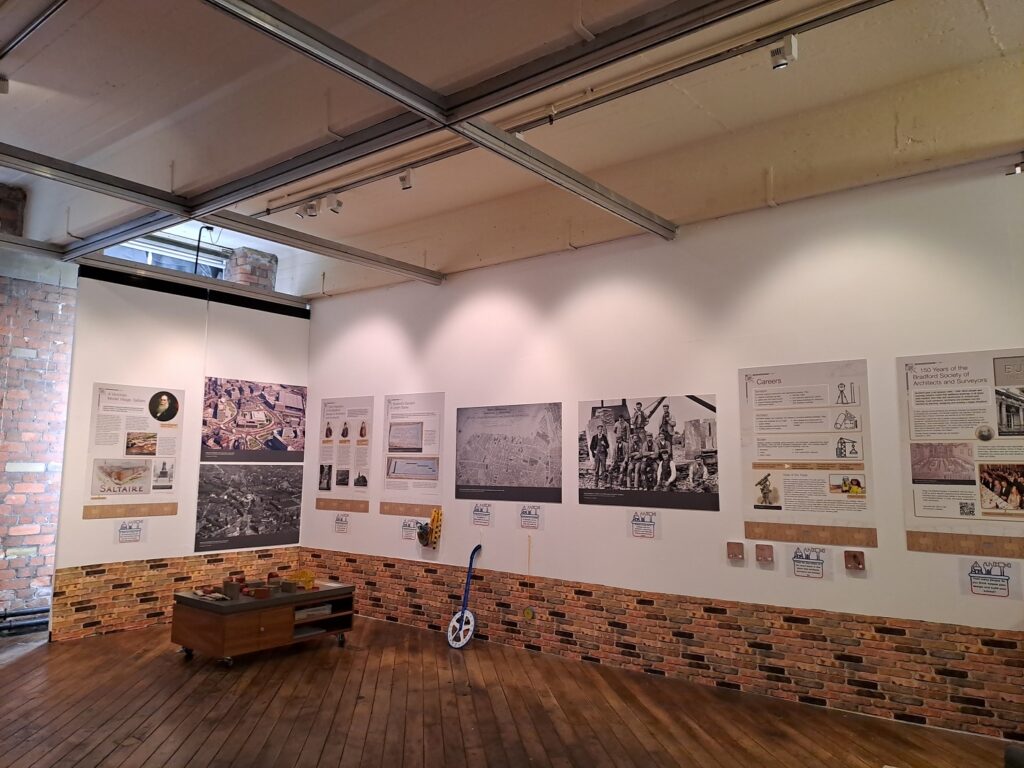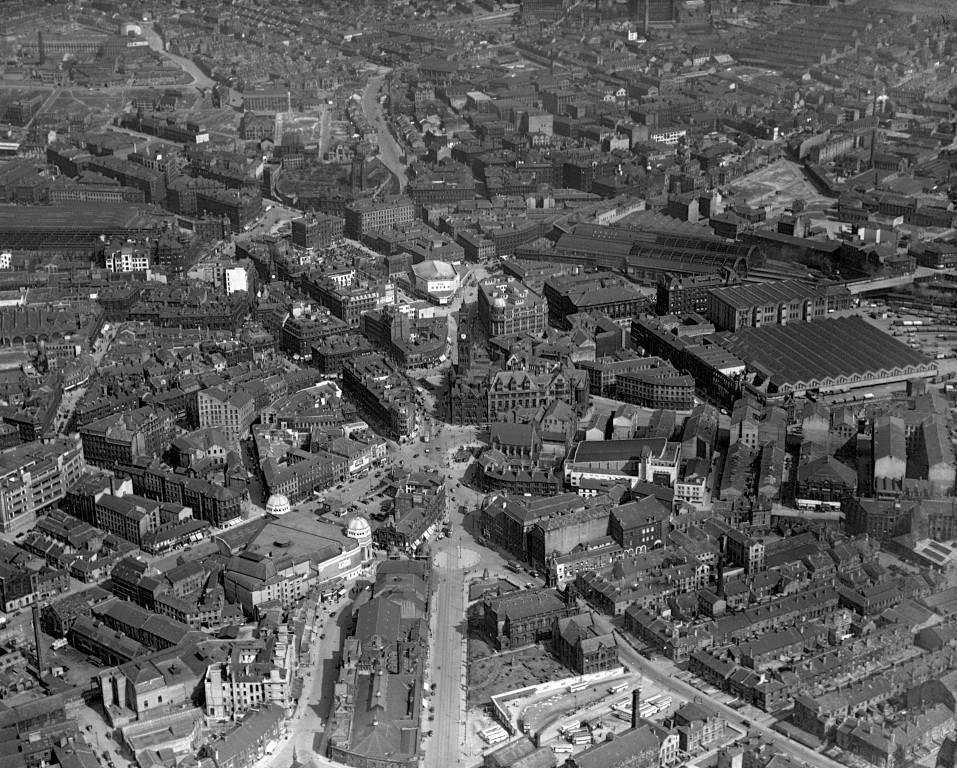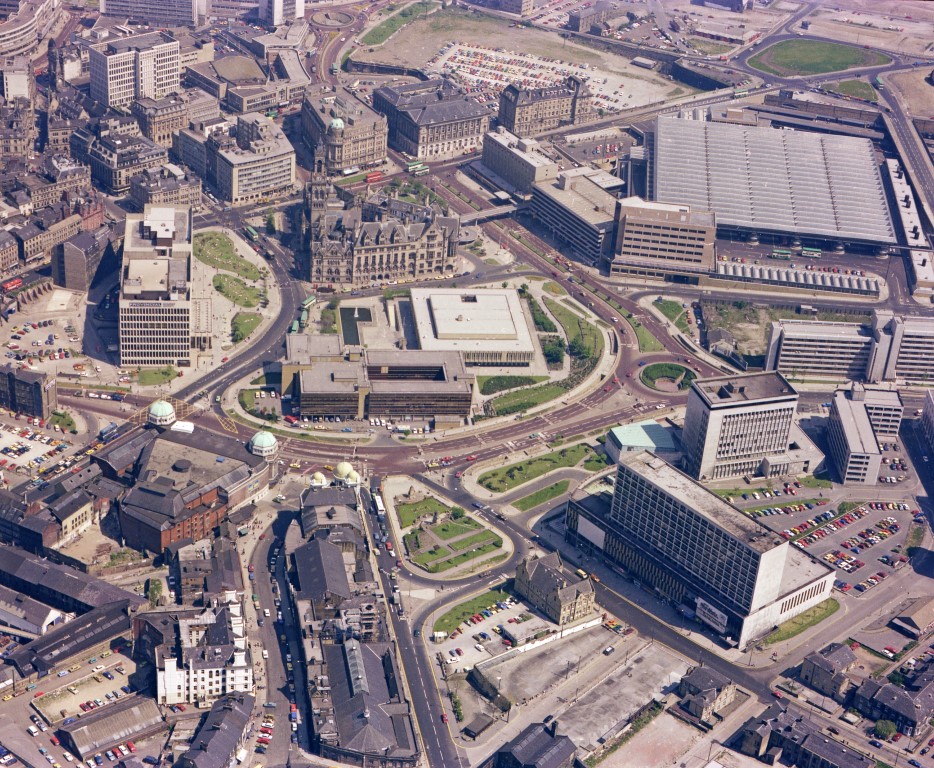Bradford District Museums and Galleries (BDMG) have worked with the Bradford Society of Architects and Surveyors to co-curate an exhibition marking their 150-year anniversary. The exhibition ‘We Built This City’: 150 Years of the Bradford Society of Architects and Surveyors launched on the 28th of September 2024 at Bradford Industrial Museum. Assistant Curator of Collections, Dr Lauren Padgett, tells us more:
In 2023, our programming working group received an external exhibition proposal from the Bradford Society of Architects and Surveyors keen to mark their 150-year anniversary in 2024 with a museum display. It was well-received and duly accepted, being allocated the large temporary exhibition space at Bradford Industrial Museum from Autumn 2024. I was assigned to curate this exhibition in partnership with them.
Since late last year and more frequently over the past several months, members of the Society’s committee have been meeting and liaising with me to plan this exhibition. From my early conversations with them, it was clear that this exhibition had immense potential; there is so much that could be included, and visitors love reminiscing about past Bradford and seeing photographs of it from years gone by.

The key purpose of this exhibition is to highlight the Society’s past and present members of architects and surveyors, and buildings and construction projects that they had worked on. From that focus, we had to devise an exhibition storyline or narrative. I liaised with members of the Society who were generous in sharing with me their knowledge of the Society’s and Bradford’s architectural history, and I undertook my own research. Our meetings always sent me down fascinating research rabbit-holes. In fact, one of our meetings sent me on a trip to Bradford city centre behind the cenotaph to look for a little-known public monument frequented by surveyors (check out the exhibition panel about Bradford’s standards of measurement display).
Once the research stage started, the exhibition started taking shape. It was decided that there would be interpretation panels providing:
- an introduction to the architect and surveyor profession and tools of their trade;
- an overview of the Society’s history;
- a potted history of how Bradford city centre has changed from the 1800s to the present day;
- and in-depth case studies about specific Society presidents and members and their building and/or construction projects.
I was also keen to reference how the contemporary construction industry is addressing today’s climate emergency with a ‘green and clean’ case study, in line with our BDMG Service priority of supporting climate emergency awareness and action.
Milnes


Internally within Bradford District Museums and Galleries, we set up an exhibition working group with myself and representatives across the Learning and Outreach Team so we could work collaboratively to develop ‘play-zones’ within the exhibition and exhibition-related events for visitors of all ages. These play-zones would be structured around the concepts of ‘planning’, ‘designing’ and ‘building’, allowing younger visitors to engage with role-play activities linked to being an architect, surveyor and builder.
Exhibition space 2

Our Photo Archive Assistant, Olivia, worked with Society committee members and me to source, digitise and provide relevant images from our photographic collection for the exhibition. These include street-scenes of Bradford taken by Christopher Pratt in the early 1900s and aerial photographs of Bradford city centre taken in the mid-20th-century by C H Wood. It’s been fascinating exploring photographs of Bradford from the late 1800s to the 2000s. The set of photographs below perfectly illustrates the process of Victorian Bradford becoming Brutalist Bradford in the mid-to-late 20th century. Many of these photographs are available to view on our online Photo Archive

Construction of Arndale House


Once interpretation text was drafted and finalised (after a round of peer-review with colleagues), and photographs selected, I worked with graphic designers from Bradford Council’s Design and Print Unit to have the exhibition panels designed and printed. There was two-week period from mid-to-late September when the temporary exhibition space was decanted of the previous exhibition so colleagues and I could rearrange the wall layout, do some painting and wallpapering to freshen up the space and give it a unique look, hang the new exhibition panels and set up the ‘play-zones’ and hands-on activities in readiness for its launch.

On Saturday 28 September 2024, members of the Bradford Society of Architects and Surveyors and invited guests came together at Bradford Industrial Museum to mark the opening on the exhibition. It was fantastic to meet the other Society members and to see visitors engaging with the exhibition – and the play-zones are a huge hit with small and big visitors! Within minutes of the museum opening, families were playing with the lightbox assembling shapes to design buildings, and putting on hard hats and hi-vis vests to start constructing a wall in the building zone. It put a smile on my face.

We hope visitors of all ages will join us for events linked to the exhibition. There is a family event day during October half-term with our tinkering challenge. We had talk by a local historian about Bradford’s lesser-known brick industry early October. We have monthly early years sessions for 0-5 year olds, specifically designed to explore aspects of the exhibition while developing skills. For more information about events, please visit our website: https://bradfordmuseums.org/whats-on/
If you are interested in Bradford’s historic and iconic buildings architecture, would like to learn something new about Bradford’s history or reminisce about Bradford’s past, then this exhibition is for you. ‘We Built This City’: 150 Years of the Bradford Society of Architects and Surveyors runs until 2 March 2025 at Bradford Industrial Museum.

Aerial of Bradford 1978

A special thanks to the Bradford Society of Architects and Surveyors, in particular Katharine Nicholas, Lesley Webb and Marcus Rathbone, for making this exhibition happen. You can find out more about the Society on their website. Also, thanks to Philip Lickley and colleagues at Bradford Cathedral for their support with us using the Cathedral as a case study in the exhibition